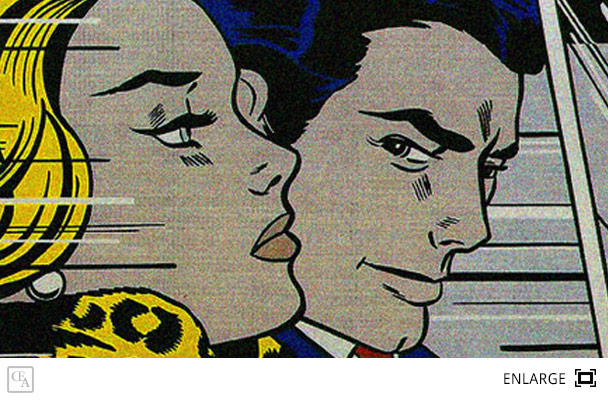
This makes it similar to Lichtenstein's more famous painting Drowning Girl which also draws inspiration from woman's romance comics and is a near-exact replica of another comic panel. Though Nurse is Lichtenstein's most valued painting to date, selling for 95 million dollars, In the Car has fetched its own decent price and was sold for 16.2 million dollars in 2005.
The painting itself depicts a man and a woman in a red car, with speed lines indicating their motion in the typical comic book fashion. The man has bluish hair and is wearing a suit and tie, looking somewhat sternly at the woman beside him. The woman is blond with pearl earrings and a leopard-print coat. She has an irritated look on her face and stares straight ahead as the car speeds forward. Little else is visible in the painting because even parts of the original panel that inspired it are cropped out. Besides the two people, only part of the windshield, part of the steering wheel, and part of the outside of the car are visible. The background is rather indistinct.
This image is typical of Lichtenstein's work, and demonstrates his fascination with women in the midst of love affairs with men who were treating them unfairly. The original comic book panel where this work took its inspiration depicts a woman angry at herself for eschewing her prior commitments in order to ride in a car with an apparently irresistible man. Many of his other paintings deal with the similar melodramatic subject of a woman fawning over a man, or else suffering tragedy from her romance. The woman's look is also quite faithful to Lichtenstein's style, as he tended to prefer very uniform comic book women with a very stereotypical style about them.
There are a few differences between the original panel and Lichtenstein's paining, though not that many. For one, the speed lines, though present in the original panel, take on a harder look in the painting. The colors are also brighter, more basic, and less realistic. For example, the man's hair is no longer brown, but a distinct bluish color, and though the woman's hair is a more natural-looking blond in the original comic, her hair is a much brighter, unrealistic yellow in Lichtenstein's version. Similarly, the woman's coat is a much brighter yellow than the flat orange of the original. The expressions on the subjects' faces are also subtly altered to depict more of a sense of irritation, as if they are sitting side by side in the car after a disagreement and have resigned themselves to a state of silence. The tension is very visible, and gives the viewer a sense of a tumultuous relationship that may be on the verge of going sour.
 Arts3 Network
Website edition
Arts3 Network
Website edition